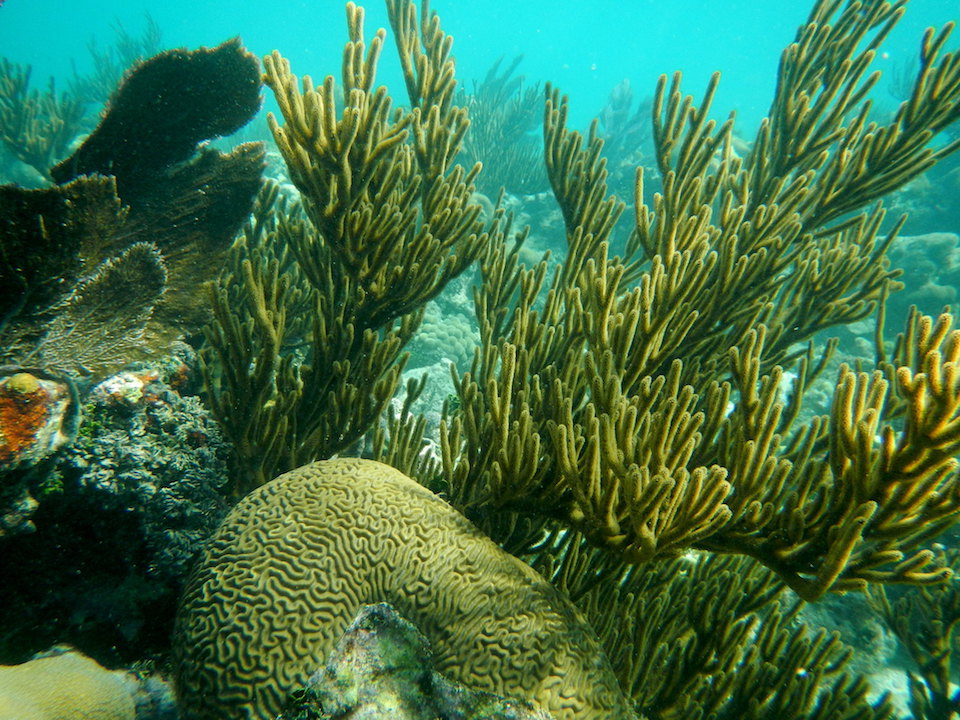- Marine & Estuarine Ecosystems
Climate Impacts on Florida's Marine & Estuarine Ecosystems

Impacts of Sea Level Rise:
- Change in type and extent of seagrass due to increased water depth affecting sunlight penetration
- Decreased salinity in Florida Bay as more mixing occurs
- New areas for migration of seagrass and oyster reefs
Impacts of Salinity Shifts:
- Increased habitat for species with broad osmoregulatory adaptations
- Increased habitat in Florida Bay, as salinity decreases with increased water depth, for species sensitive to hypersaline conditions
Impacts of Warmer Summer Temperatures:
- Increased cyanobacteria blooms
- Increased coral mortality due to loss of coral zooxanthellae and bleaching
- Expansion of harmful algal bloom season and persistence
- Less dissolved oxygen in the system
Impacts of Warmer Winter Temperatures:
- Increased local extirpations of species at the southern extent of their range
- Expansion of harmful algal blooms season and persistence
Impacts of Increased Extreme Heat Events:
- Increased cyanobacteria blooms
- Increased coral mortality due to loss of coral zooxanthellae and bleaching
- Expansion of harmful algal bloom season and persistence
- Less dissolved oxygen in the system
- Altered abundance and species composition of seagrasses
- Increased mortality – heat stress
- Reduced reproductive success – coral and mollusk reefs
- Altered growth/biomass
- Increased competition – conditions favoring algae and epiphytes
Impacts of Increased Extreme Cold Events:
- Increased mortality of cold temperature sensitive species
- Increased occurrence and severity of cold kill events
- Limit northern extent of exotic species range (potentially beneficial change)
Impacts of Increased Precipitation:
- Nearshore vegetation mortality increase due to salinity decrease
- Increased coral mortality due to decreased light penetration (increased turbidity)
- Increased coral mortality due to increased nutrient loads
- Increased coral mortality due to disease outbreaks
- Increase in frequency/severity of harmful algal blooms
- Altered runoff and buffering ability of the system
Impacts of Decreased Precipitation:
- Decreased freshwater flow and runoff into coastal systems
- Decreased nursery and juvenile habitat
- Increased mortality of vegetation due to increased salinity
Impacts of Changes in Timing of Precipitation:
- Increased mortality of vegetation due to increased salinity as water chemistry in bays and estuaries change
Impacts of Changes in Frequency and Severity of Extreme Events:
- Alteration of longshore transport process
- Increased sedimentation and turbidity (decreased light penetration)
- Decreased stability of systems
- Direct physical damage
- Increased runoff into coastal waters with increased storm intensity
- Disruption of the interspecies dynamics due to varying spatial and temporal changes
Impacts from Increased Floods:
- Altered sediment build-up patterns in coastal marshes and estuaries
- Habitat degradation at various temporal and spatial scales
- Loss of habitat integrity due to issues such as sediment transport
Impacts from Increased Droughts:
- Changes in habitat distribution
- Increased erosion due to reduced effectiveness of dune stabilizing plants
- Altered salinity levels and seasonal salinity profiles
- Increased of pollutants in runoff due to lack of regular flushing of build-up
- Reduction in habitat quality and area (volume)
Impacts of Altered Water Chemistry:
- Decreased coral reef health/productivity due to reduced calcification and/or enhanced dissolution
- Decreased oyster reef health/productivity due to reduced calcification and/or enhanced dissolution
- Decreased coral reef recruitment processes (fertilization, settlement, and post-settlement growth)
- Decline in primary productivity
- Shifts in range of seagrass species
- Increased harmful algal blooms, especially when coupled with increased nutrient inputs
- Increased seagrass production
- Increased production and biomass of epiphytic algae on seagrass leaves
- Increased competition (seagrass and algae)
What's next?
Learn about climate-related impacts to terrestrial ecosystems in Florida.